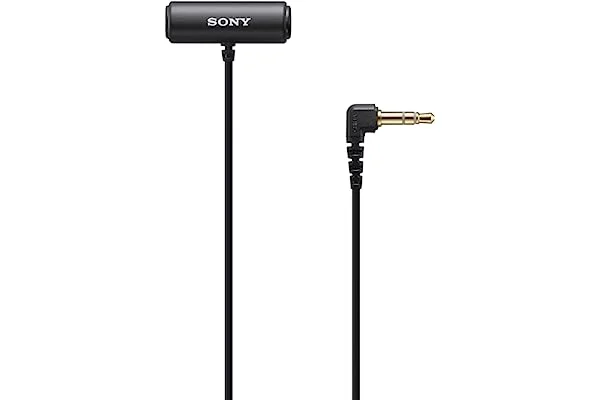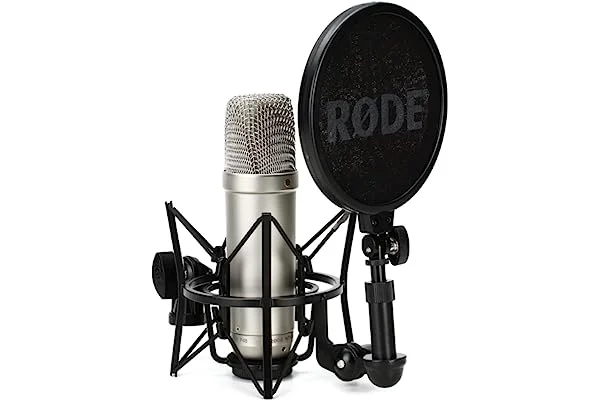Features
Sony ECM-LV1 Lavalier Microphone

- HIGH QUALITY SOUND: This Lavalier mic delivers crystal clear audio with high quality omni-directional pickup with reduced unwanted noise. Even further improved audio quality when used with the ECM-W2BT wireless microphone and a camera with a multi-interface shoe that supports digital audio capture.
- FLEXIBILITY: 360-degree rotation clip mic for freedom of horizontal attachment to a necktie, or vertical attachment to a pocket with the microphone attached at the same angle.
- PORTABLE: A compact design for unobtrusive tie, pocket or lapel mic attachment that can be transported effortlessly.
- IN THE BOX: Wind screen included to reduce noise when outside in strong winds that may interfere with audio recording.
Rode NT1-A

- Large diaphragm 1” gold-sputtered capsule
- Cardioid polar pattern
- Ultra-low noise, self-noise of only 5dB (A)
- Includes Rode SM6 shock mount, pop filter and dust cover
Introduction
Are you looking for the perfect microphone to capture audio with crystal-clear clarity? If so, you may be torn between two of the most popular options on the market: the Sony ECM-LV1 Lavalier Microphone with Stereo Sound Capture and the Rode NT1-A Anniversary Vocal Cardioid Condenser Microphone Package. Both of these products offer high-quality sound recording, but which one is the right choice for you?
In this blog post, we’ll compare the Sony ECM-LV1 and the Rode NT1-A to help you make an informed decision. We’ll look at their features, sound quality, and price points to give you a comprehensive overview of each product. By the end of the post, you’ll be equipped with all the knowledge you need to choose the perfect microphone for your needs.
Features
Let’s start by exploring the features of each product. The Sony ECM-LV1 is a lavalier microphone that offers stereo sound capture and a low-noise preamp. It has an omnidirectional pickup pattern, which means it can pick up sound from all directions. The microphone also has a slim and lightweight design, making it easy to use and transport.
The Rode NT1-A, on the other hand, is a cardioid condenser microphone that offers a wide frequency response and a low self-noise. It has a classic, vintage-style design and comes with a pop filter, shock mount, and dust cover. The microphone also features a built-in pop filter and a gold-plated XLR output.
Sound Quality
Now let’s take a look at the sound quality of each product. The Sony ECM-LV1 is designed to capture audio with clarity and accuracy. It offers a wide frequency response and low noise, making it perfect for recording voiceovers and interviews. The microphone also has a wide dynamic range, allowing you to capture a wide range of sounds.
The Rode NT1-A is designed to capture audio with pristine clarity and detail. It has a wide frequency response and low self-noise, making it perfect for recording vocals and acoustic instruments. The microphone also has a high SPL handling, allowing you to capture loud sounds without distortion.
Price
Finally, let’s compare the price points of each product. The Sony ECM-LV1 is priced at around $99, making it an affordable option for those on a budget. The Rode NT1-A, on the other hand, is priced at around $229, making it a more expensive option.
Conclusion
The Sony ECM-LV1 and the Rode NT1-A are both excellent microphones that offer high-quality sound recording. The Sony ECM-LV1 is a lavalier microphone that offers stereo sound capture and a low-noise preamp. It is an affordable option for those on a budget. The Rode NT1-A is a cardioid condenser microphone that offers a wide frequency response and a low self-noise. It is a more expensive option, but it is designed to capture audio with pristine clarity and detail.
Ultimately, the choice of which microphone is right for you will depend on your budget and your recording needs. We hope this blog post has helped you compare the Sony ECM-LV1 and the Rode NT1-A and make an informed decision.
Specifications / Attributes
| Feature | Sony ECM-LV1 Lavalier Microphone | Rode NT1-A |
|---|---|---|
| Batteries | 1 Lithium Ion batteries required. | 1 Lithium Ion batteries required. |
| Batteries Included | No | No |
| Batteries Required | No | No |
| Brand | Sony | Rode Microphones |
| Compatible Devices | Camera | Radio |
| Connector Type | Auxiliary | Wired |
| Date First Available | 12 March 2021 | 1 April 2018 |
| Graphics Card Interface | PCI-Express x16 | N/A |
| Hardware Interface | PCI Express x16 | N/A |
| Hardware Platform | Camera | N/A |
| Includes AC Adapter | N/A | No |
| Includes Rechargeable Battery | N/A | No |
| Is discontinued by manufacturer | N/A | No |
| Item Model Number | ECM-LV1 | NT1 3rd Gen |
| Item Weight | 12 g | 2.09 kg |
| Manufacturer | Sony | Rode |
| Material Type | N/A | Nickel |
| Microphone format | Lavalier | Microphone Only |
| Model | ECM-LV1 | NT1 3rd Gen |
| Model Name | ECM-LV1 | NT1-A |
| Model year | N/A | 2014 |
| Mounting Hardware | Wind Screen, Stereo Lavalier Microphone | microphone |
| Noise level | N/A | 5 dB |
| Number of items | 1 | 1 |
| Part Number | ECM-LV1 | NT-1A |
| Power Source | Corded Electric | AC |
| Product dimensions | 29.99 x 5.16 x 12.69 cm; 12 Grams | 27.05 x 21.34 x 17.27 cm; 2.09 Kilograms |
| Signal-to-noise ratio (dB) | 35 dB | 75 dB |
| Special Features | Portable | RODE's NT1-A is one of the world's quietest microphones! Why is that important? Low noise will give your work the dynamics you deserve. Adding noise from any device, especially at the source, only degrades your performance. The NT1-A has a self-noise of only 5 dB-A! The NT1-A can handle 137dB SPL so you can be confident that even in front of loud guitar cabinets, your recording won't distort due to overload. By providing ultra-quiet operation and being versatile enough to handle a wide variety o |
| Check the Best Deal Price Today | Check the Best Deal Price Today |







